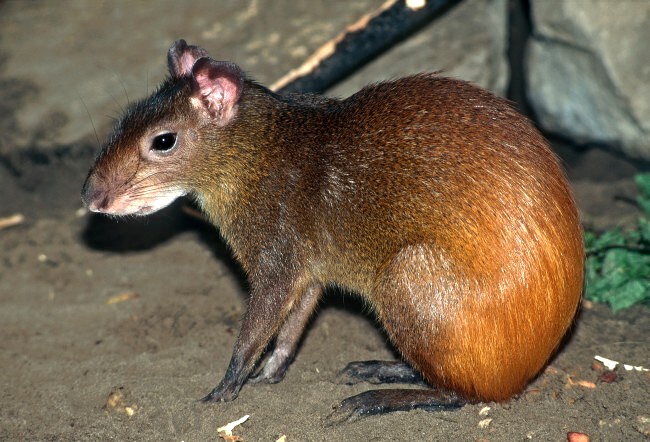The Red-Rumped Agouti (Dasyprocta leporina) is a rodent mammal (like a rat or guinea pig). They are native to South America and are important members of their ecosystem, because they are the only mammals within their native range that are able to open the husk of a Brazil nut. Known as the Golden-Rumped Agouti, Orange-Rumped Agouti, or Brazilian Agouti, can be found at the Iwokrama River Lodge, Arrowpoint Nature Resort and Guyana rainforest. This species can live upwards of 15 to 20 years in human care.
Where Does The Red-Rumped Agouti live?
The agouti is native to the northeast of South America, and is found in Venezuela, Guyana, French Guiana, Suriname, northeastern Brazil, the Lesser Antilles, Trinidad and Tobago. It has been introduced in the Virgin Islands. Agoutis live in a wide range of habitats where good cover exists, especially near old logs, swamps and bodies of water. They sometimes live near humans on farms and in gardens. However, they seem to prefer all types of forests to human-inhabited areas.
Description Of The Red-Rumped Agouti
They have coarse, glossy fur that is typically greenish-brown in color. Their rumps are orange to red, and their undersides are orange-brown with a white stripe running down the center. Red-rumped agoutis have four toes on their front feet, but only three on their hind feet. Their ears are small and round.
They weigh between 6.6 and 13 pounds (3 to 5.9 kilograms), and grow to between 19 and 25 inches (49 to 64 centimeter) long. Their tails are typically no longer than 2.4 inches in length (6 centimeters). Females are typically larger than males.
Communication Of The Red-Rumped Agouti
They communicate through a series of grunts, squeals and screams, as well as through posturing.
Behavior Of The Red-Rumped Agouti
The agouti is diurnal, but if it feels threatened it will not feed until dusk. They live in small groups, which helps them to better monitor predators. They live in burrows under rocks, in sloping banks or between tree roots. They can jump nearly six feet up in the air. They often sit with erect bodies and with ankles flat to the ground so that they can run off at full speed when threatened. If they are disturbed, they may thump on the ground with their back feet. They can use many vocalizations, most notably an alarm bark at the time of running from danger.
Feeding Habits Of The Red-Rumped Agouti
The main ingredients in an agouti’s diet are fruit and seeds, though they eat leaf, plant and animal parts when fruit and seeds are in short supply.
Reproduction Of The Red-Rumped Agouti
Agoutis are monogamous, one male mating with one female only. They live in pairs or in small family groups of parents and offspring. The male aggressively chases away intruding agoutis and this vicious fighting can result in severe wounds. There is no distinct breeding season. Usually 1 to 3 young are born, after a gestation period of 104 to 120 days. Babies can run at only an hour after being born. It takes about 20 weeks until the young are weaned.
Fascinating Facts About The Red-Rumped Agouti
- They will follow troops of monkeys through the forest and eat fruits that they drop.
- There are 13 different species of agouti and their scientific name “Dasyprocta” means “fuzzy butt.”
- Agoutis can swim.
Red Rump Agouti
Red-rumped agoutis, which weigh between 6 and 13 pounds, are native to French Guiana, Guyana, Suriname, Trinadad and Tobago. While they prefer forest environments, they can also be found in thick brush and savannahs. Their diet consists of seeds, fruits, roots and leaves. When food is abundant, they will bury it to save for a time when food is scarce. In doing so, red-rumped agoutis serve as important seed dispersers for many trees including Brazilian nut trees.







